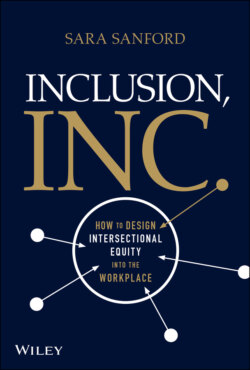Читать книгу Inclusion, Inc. - Sara Sanford - Страница 13
The DEI Overwhelm
ОглавлениеI was asked during a recent interview to pick one word to describe how business leaders feel about DEI. I think they were looking for “committed” or “optimistic.”
I chose “overwhelmed.”
This feeling isn't limited to business leaders. I spend my days listening to employees across all levels of organizations talk about what diversity and inclusion mean to them. In these conversations, I hear a lot of recurring themes:
White employees want to support their peers of color but don't know where to start.
Employees of color are told over and over again, “We need to hear voices like yours. We need more people of color to speak up.” Then, they do speak up and they hear, “You're making your peers uncomfortable. You should just focus on leading your team. You're pulling the race card.” Some find, after speaking up, that they're suddenly left out of meetings and important projects.
Men want to be allies, but they're worried they're going to say the wrong thing.
Women take advice to “Lean In” and stand up for themselves or negotiate for a raise, only to be told they're too aggressive or arrogant. Other women see these consequences and avoid speaking up, and then are told it's their own fault that their careers aren't progressing.
Managers and executives start to explore DEI strategies and become paralyzed by an ever-changing DEI vocabulary, contradictory messages, and seemingly endless nuance. If they do implement new inclusive policies, they find a new segment of their employee base is angry at them.
Employees who feel their neurodivergent status, age, or caretaking responsibilities impact how they're treated at work aren't sure they have a “right” to speak up, because what they're experiencing doesn't seem as bad as overt racism or sexism.
This is just the beginning. Whatever the particular mix of overwhelm looks like in each organization, I see the same repeated outcomes: Underestimated employees eventually realize their only choices are to assimilate or leave, and the businesses and employees both miss out. (Arlan Hamilton coined the term “underestimated” to refer to groups that have historically experienced bias.) Even if businesses manage to hold on to these employees, employers won't get the benefits of their unique insights, since they will never feel comfortable showing up authentically.
Employees who do choose to leave find they don't know how to determine if another employer will be better. Many “Most Inclusive Workplaces” lists are sponsored, or their criteria are unclear or unsubstantiated. Large organizations that appear more diverse than others don't show their attrition numbers. They may just be in a continuous cycle of losing and rehiring employees to keep their diversity numbers up. Alternatively, they may have diverse overall numbers, but zooming in could reveal that none of that diversity shows up in leadership.
Employees don't know where to look. Employers don't know what to do. In general, there's a lack of clarity about what works—what behaviors, processes, and practices should be tracked to catalyze progress toward equity at work.
I wrote Inclusion, Inc to provide this clarity.
To get out from under the overwhelm, we have to start by understanding the status quo. What have businesses been doing to address DEI, and why isn't it working?
